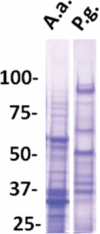Immunoglobulin G antibodies against Porphyromonas gingivalis or Aggregatibacter actinomycetemcomitans in cardiovascular disease and periodontitis
- PMID: 29081914
- PMCID: PMC5646634
- DOI: 10.1080/20002297.2017.1374154
Immunoglobulin G antibodies against Porphyromonas gingivalis or Aggregatibacter actinomycetemcomitans in cardiovascular disease and periodontitis
Erratum in
-
Corrigendum.J Oral Microbiol. 2018 Jan 31;10(1):1433122. doi: 10.1080/20002297.2018.1433122. eCollection 2018. J Oral Microbiol. 2018. PMID: 38812580 Free PMC article.
Abstract
Objectives: The aim was to elucidate whether levels of circulating antibodies to Actinobacillus actinomycetemcomitans and Porphyromonas gingivalis correlate to loss of attachment, as a marker for periodontitis and cardiovascular disease (CVD). Design: Sera were collected from 576 participants of the Danish Health Examination Survey (DANHES). Immunoglobulin G antibodies against lipopolysaccharide (LPS) and protein antigens from the a, b and c serotypes of A. actinomycetemcomitans and P. gingivalis were quantified by titration in ELISA plates coated with a mixture of antigens prepared by disintegration of bacteria. Results: Levels of antibodies against P. gingivalis (OR = 1.48) and A. actinomycetemcomitans (1.31) associated with periodontitis, as determined by univariable logistic regression analysis. These antibody levels also associated with CVD (1.17 and 1.37), respectively, However, after adjusting for other risk factors, including age, smoking, gender, alcohol consumption, overweight, and level of education using multivariable logistic regression analysis, only increasing body mass index (BMI; 1.09), previous smoking (1.99), and increasing age (decades) (2.27) remained associated with CVD. Increased levels of antibodies against P. gingivalis (1.34) remained associated with periodontitis after adjusting for other risk factors. Conclusions: CVD and periodontitis were associated with levels of IgG antibodies to P. gingivalis or A. actinomycetemcomitans in univariable analyses, but only the association of P. gingivalis antibody levels with periodontitis reached statistical significance after adjustment for common confounders. Age, in particular, influenced this relationship.
Keywords: Cardiovascular disease; antibody; atherosclerosis; cohort study; hypertension; immunoglobulin; myocardial infarction; periodontal disease; periodontitis; risk factor.
Conflict of interest statement
No potential conflict of interest was reported by the authors.
Figures


References
-
- Armitage GC. Development of a classification system for periodontal diseases and conditions. Ann Periodontol. 1999;4:1–6. - PubMed
-
- Rydén L, Buhlin K, Ekstrand E, et al. Periodontitis increases the risk of a first myocardial infarction. A report from the PAROKRANK Study. Circulation. 2016;133(6):576–583. - PubMed
LinkOut - more resources
Full Text Sources
Other Literature Sources
